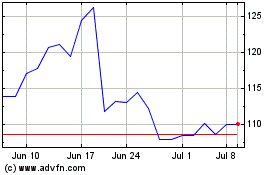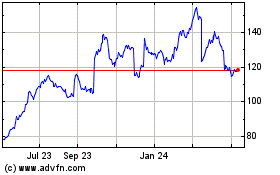Researchers Envision Ultrathin, Flexible Circuit Boards
September 03 2016 - 5:59AM
Dow Jones News
By Don Clark
SAN JOSE, Calif. -- Silicon Valley is rethinking one of its
least glamorous and most ubiquitous building blocks, the circuit
board, in a bet that flexible, form-fitting alternatives could
reshape electronics and spur more manufacturing in the U.S.
Backers envision ultrathin boards like skin patches that could
analyze the sweat of soldiers and pilots, wrap around gas pipelines
and act as leak detectors, or provide grids of flexible sensors
able to detect stress on airplane wings.
Such possibilities -- the focus of a new manufacturing
consortium here backed by the U.S. Department of Defense and others
-- require materials and production techniques that differ from
conventional circuit boards, made of stiff plastic.
In some cases, circuitry is imprinted on paper, plastic or other
organic materials using processes akin to inkjet printing. The
results, which can be as thin as temporary tattoos, can be tailored
for extended contact with the skin or in large formats applied to
walls or roofs.
The concept of applying printing techniques to electronics has
been around for more than a decade. Raghu Das, chief executive of
the research firm IDTechEx, said past efforts in the field largely
have failed because they attempted to replace silicon chips, which
remain less expensive and more powerful for many purposes.
Instead, researchers now are looking to replace the circuit
boards on which chips are placed, using techniques they call
flexible hybrid manufacturing. Techniques include wiring
semiconductors together on flexible surfaces, creating products
that are more versatile than existing circuit boards.
"All the other electronics out there is in a box," said Malcolm
Thompson, executive director of the San Jose institute known as
NextFlex. "We are out of the box."
Progress may not come quickly. Though suppliers of materials and
manufacturing technology are pushing the concept aggressively, Mr.
Das said flexible electronics has suffered from a dearth of
inventors applying the techniques in new products.
Besides expanding where technology can go, companies and
government officials hope the new approach can influence where it
is built.
Most high-volume production of chips and other electronic
devices long ago moved from Silicon Valley to China and other
lower-cost locations. But manufacturing specialists like Jabil
Circuit Inc. and Flextronics International Ltd. keep facilities in
the U.S. to help customers design products and build
prototypes.
Flexible hybrid manufacturing could offer more opportunities for
such work, some industry executives say, as companies devise new
gadgets that must be introduced quickly and evolve rapidly.
"We are very interested and curious about democratizing
manufacturing," said Janos Veres, program manager for novel and
printed electronics at Palo Alto Research Center Inc., a unit of
Xerox Corp. Flexible electronics, he said, "will open up a whole
new raft of business models."
Some executives hope U.S. companies develop proprietary know-how
to make flexible circuitry, which could make it harder for foreign
factories to produce the same products. "You don't want to share
it," said Daniel Gamota, vice president of Jabil's hardware
innovation group.
Techniques derived from printing are widely used to embed tiny
wires in places like car windshields, antennas, solar cells and
radio-frequency identification tags. Computer displays also are
being fabricated using plastic, including organic light-emitting
diodes. IDTechEx predicts flexible electronics revenue including
those displays will triple to $26.2 billion by 2020 from $8.6
billion this year.
One key development, Mr. Thompson said, has been techniques
devised by companies such as American Semiconductor Inc. and
Uniqarta Inc. to make thinner silicon wafers for chip production.
In some cases, the resulting chips can be rolled up like a piece of
paper.
The U.S. military's interest stems partly from a desire to
reduce the weight of gear soldiers must carry and to track their
condition. Mr. Thompson said flexible sweat-monitoring sensors can
detect chemicals that indicate fatigue on wearers on the
battlefield or in cockpits.
Boeing Co. on Wednesday showed off flexible antennas that could
be deployed on aircraft for radar and other applications. Other
efforts are aimed at intelligence agents who need to keep
information out of enemy hands. PARC engineers have worked under a
Pentagon research program to print information on glass that could
disintegrate into unreadable bits in response to a remote
command.
NextFlex, whose funding includes $75 million from the Defense
Department, is among several institutes the Obama administration
has set up to encourage collaboration in manufacturing technology.
The institute is installing tools to help experiment with
production techniques and funding development projects at corporate
and university labs.
Write to Don Clark at don.clark@wsj.com
(END) Dow Jones Newswires
September 03, 2016 05:44 ET (09:44 GMT)
Copyright (c) 2016 Dow Jones & Company, Inc.
Jabil (NYSE:JBL)
Historical Stock Chart
From Jan 2025 to Feb 2025

Jabil (NYSE:JBL)
Historical Stock Chart
From Feb 2024 to Feb 2025
